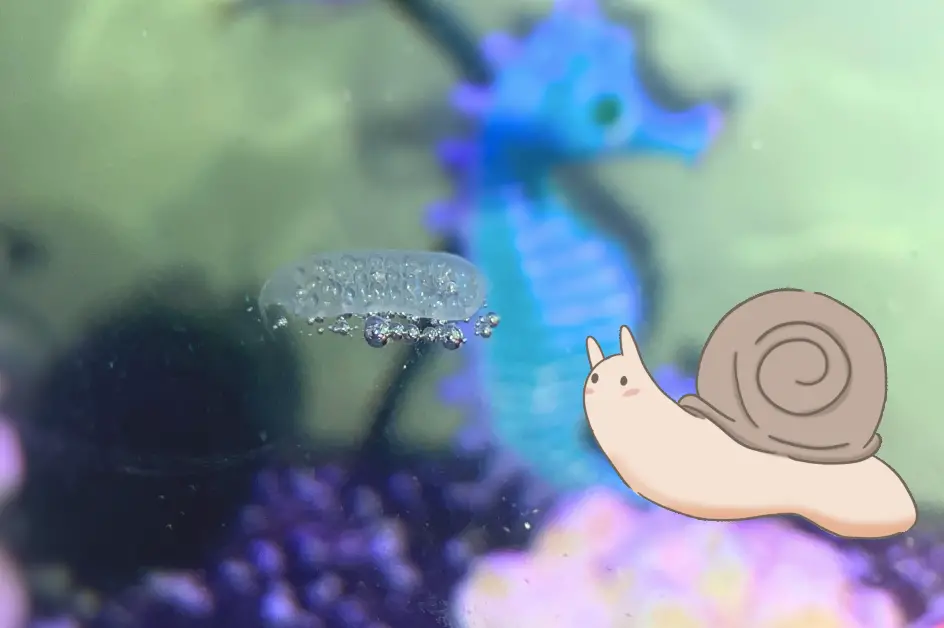Freshwater snail eggs are a common sight in aquariums, and knowing what to do with them can be a challenge for many aquarium owners. Fortunately, there are several options available for dealing with these eggs, depending on your preferences and goals.
One option is to simply leave the eggs in the aquarium and allow them to hatch naturally. This can be a great way to add more snails to your aquarium, which can help keep the tank clean and healthy. However, it’s important to note that some species of snails can reproduce rapidly, so keeping an eye on the population is important to prevent overcrowding.
Another option is to remove the eggs from the aquarium and dispose of them before they hatch. This can be a good choice if you don’t want to add more snails to your tank or if you’re concerned about the potential for overpopulation. Some aquarium owners choose to feed the eggs to certain fish species, which can be a healthy and natural source of food. Whatever your preference, it’s important to take action quickly, as snail eggs can hatch in as little as a few days.
Identifying Freshwater Snail Eggs
When it comes to identifying freshwater snail eggs, it’s important to note that each species lays unique eggs that are distinct and identifiable. However, there are some general characteristics that can help you identify snail eggs in your aquarium.
One common characteristic is that snail eggs are usually laid in clusters or groups. These clusters can range in size from just a few dots to larger, more noticeable clusters.
Another characteristic of snail eggs is that they are often translucent or clear in color, allowing you to see the embryo developing inside. This can be a fascinating sight for aquarium enthusiasts!
Depending on the species, snail eggs can also vary in shape and texture. Some eggs may be round and smooth, while others may be oblong and have a bumpy texture.
One thing to keep in mind is that not all snail eggs will hatch. Some may be infertile or may not develop properly. If you notice that some of the eggs in a cluster are not hatching, it’s best to remove them from the aquarium to prevent any potential health issues.
Overall, identifying freshwater snail eggs can be an interesting and educational experience for aquarium enthusiasts. By understanding the characteristics of snail eggs, you can better care for your aquarium and its inhabitants.
What To Do With Freshwater Snail Eggs
If you have freshwater snails in your aquarium, chances are you will encounter snail eggs at some point. What should you do with them? Here are our options:
Leave Them Alone
One option is to simply leave the snail eggs alone and let them hatch. Snail eggs can take anywhere from a few days to several weeks to hatch, depending on the species and water temperature. If you have a snail hatchery or breeding tank, you can transfer the eggs there for better incubation. Once the snails hatch, they will start to reproduce and help keep your tank clean by eating algae and other debris.
Remove Them
Another option is to remove the snail eggs from your aquarium. This is especially important if you have too many snails in your tank and you don’t want them to overpopulate. Removing the eggs can also help prevent your aquarium substrate from becoming overcrowded with snails.
To remove the eggs, you can use a scraper or a net to gently lift them out of the water. You can also use a turkey baster or a pipette to suck them up. Be sure to dispose of the eggs properly. You can either throw them in the trash or compost them.
It’s important to note that snail eggs can be difficult to remove completely, so you may need to repeat the process several times to get rid of all of them. Additionally, removing snail eggs can be tricky if you have live young in your aquarium, as the eggs may be attached to them.
In conclusion, what you do with freshwater snail eggs in your aquarium depends on your needs as an aquarist. You can either leave them alone and let them hatch, or remove them to prevent overpopulation. Regardless of what you choose, it’s important to monitor your aquarium water temperature and substrate to ensure that your snails are healthy and happy.
Preventing Freshwater Snail Egg Infestations
As responsible aquarium owners, we want to prevent snail egg infestations in our tanks. Here are some effective methods to control and prevent snail eggs from taking over your aquarium.
Control Feeding
Overfeeding your fish can lead to an increase in waste, which can attract snails. To prevent snail eggs from hatching in your aquarium, we recommend controlling feeding and avoiding high-protein foods. Instead, consider using algae wafers or vegetables as a supplement to your fish’s diet.
Clean The Tank Regularly
Regular cleaning of your aquarium is essential to prevent snail egg infestations. We recommend cleaning the tank at least once a week and removing any debris or waste that may have accumulated. You can also use a razor blade to scrape off any snail eggs attached to the glass or plant leaves.
Choose The Right Tank Mates
Choosing the right aquarium inhabitants is crucial to prevent snail egg infestations. Certain fish, such as pufferfish, betta fish, dwarf chain loach, zebra loach, bala shark, and gourami, are known to eat snails and their eggs. Additionally, adding an algae eater or a cleaning crew to your tank can help keep the tank clean and prevent snail eggs from hatching.
Quarantine New Plants And Decorations
New live plants and decorations may contain hitchhikers, including snail eggs. Before adding them to your tank, we recommend quarantining them in a separate tank for a few weeks to ensure that there are no snail eggs present. You can also rinse the plants and decorations with a bleach solution to kill any snail eggs.
Use Snail Traps
If you already have a snail infestation, using a snail trap can help control their population. Snail traps are designed to attract and capture snails, preventing them from laying eggs in your aquarium. You can also manually remove any visible snail eggs from the tank to prevent them from hatching.
By following these methods, you can prevent snail egg infestations in your aquarium and maintain a healthy and clean environment for your fish. Remember to clean your tank regularly, choose the right tank mates, control feeding, quarantine new plants and decorations, and use snail traps if necessary.
What To Do With Hatched Snail Eggs
Identify The Species
Before we can determine what to do with hatched snail eggs, we need to identify the species of snail. Each freshwater snail species lays unique eggs that are distinct and identifiable. Some of the common snail species that you may find in your aquarium include ramshorn snails, apple snails, nerite snails, rabbit snails, trumpet snails, Malaysian trumpet snails, mystery snails, bladder snails, and pond snails.
Provide The Right Environment
Once you have identified the species of snail, it is important to provide the right environment for them to thrive. Some snail species require specific water conditions, such as brackish water or a certain pH level. It is important to research the needs of your specific snail species to ensure that they are living in a suitable environment.
Control The Population
Snails are known for their ability to reproduce quickly, which can lead to overpopulation in your freshwater tank. To control the population, you can remove some of the snails or their eggs manually. You can also introduce fish species, such as loaches or catfish, that will eat the snails and their eggs. It is important to monitor the snail population regularly to prevent overpopulation and maintain good water quality.
In conclusion, hatched snail eggs in your freshwater tank can be a sign of healthy sexual reproduction in your snail population. It is important to identify the species of snail, provide the right environment, and control the population to ensure that your snails and other aquatic life thrive in your freshwater tank.
Frequently Asked Questions
How to identify snail eggs in your aquarium?
Identifying snail eggs in your aquarium can be tricky, as each species lays unique eggs that are distinct and identifiable. However, most snail eggs are small, round, and translucent or white in color. They are usually found attached to aquarium walls, plants, or decorations. Some species of snail, such as the apple snail, lay their eggs above water. Apple snail eggs, in particular, appear in a pinkish-red cluster and contain a toxin that makes them inedible for other predators.
How long does it take for snail eggs to hatch?
The time it takes for snail eggs to hatch depends on the species and the water temperature. In general, most snail eggs hatch within two weeks to a month. Some species may take longer, while others may hatch in just a few days.
What to do with unwanted snail eggs in your aquarium?
If you do not want to keep the snail eggs in your aquarium, you have a few options. You can remove them manually using a scraper or sponge. Alternatively, you can use a chemical treatment to kill the eggs. However, be careful when using chemicals, as they can harm other aquatic life in your tank.
Can you keep snail eggs in a separate container?
Yes, you can keep snail eggs in a separate container if you want to hatch them outside of your aquarium. However, you will need to provide the right conditions for the eggs to hatch and the baby snails to survive. This includes keeping the water temperature and pH levels stable, providing enough food, and ensuring good water quality.
How to prevent snail eggs from hatching in your aquarium?
To prevent snail eggs from hatching in your aquarium, you can manually remove them as soon as you spot them. You can also limit the amount of food available in your tank, as snails need food to reproduce. Additionally, you can introduce snail-eating fish or invertebrates to your tank, such as loaches or assassin snails.
What are the risks of leaving snail eggs in your aquarium?
Leaving snail eggs in your aquarium can lead to an overpopulation of snails, which can cause problems such as excess waste, algae growth, and damage to plants. Additionally, some species of snail can carry diseases that can harm other aquatic life in your tank. It is important to monitor the snail population in your aquarium and take action if necessary to prevent any negative consequences.
Author
-

Lawrence, the founder of Pet Ploy, established the website in mid-2023. With a lifelong love for pets, Lawrence has been surrounded by a variety of animals since his early years. From dogs and cats to guinea pigs, rabbits, fish, and more, he has experienced the joy of caring for a diverse range of pets. Drawing from his deep-rooted passion, Lawrence created Pet Ploy to share his knowledge and enthusiasm with fellow pet enthusiasts. Through the platform, he aims to provide valuable insights, tips, and resources to promote the well-being and happiness of pets everywhere.











